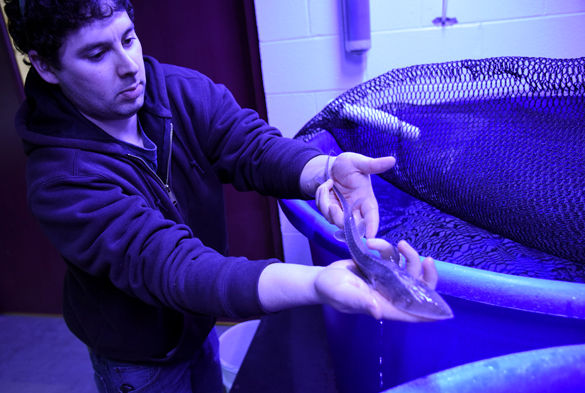McLafferty now home to beer, fish and lasers
January 26, 2016
During winter break, a nearly empty McLafferty Annex was transformed into what is becoming a state-of-the-art research center.
The Board of Trustees in 2012 approved $3 million for developing McLafferty Annex — which previously stored books during renovations to Morris Library — into a research facility. An additional $1 million was approved for equipment, according to Jim Garvey, interim vice chancellor for research.
“The idea was to make this a building that was available for interdisciplinary research and creative activity on campus,” he said.
Advertisement
So far, three interactive lab spaces are ready for research.
Fermentation Science Institute
{{tncms-asset app=”editorial” id=”14388fe4-c3e9-11e5-86aa-ef93cd265e7a”}}
In a new, glass-walled classroom students will be able to make, taste-test and analyze alcoholic beverages as part of the first fermentation lab at SIU.
Matt McCarroll, professor of chemistry and biochemistry and director of the fermentation institute, said the lab is one of the first in the Midwest. Fermentation science, he said, includes beer, wine, spirits and food production.
The lab portion of the class — Chem 180/181: the Chemistry of Beer and Brewing — is restricted to students 21 years and older and involves beer-tasting and yeast and flavor analysis. The lecture component has no age restriction.
“There’s so much growth potential and need for brewing [sciences],” McCarroll said. He said the research is necessary as it becomes more popular for people to own and operate their own breweries.
Advertisement*
He said the four-year degree program in fermentation sciences is pending final approval by the state this spring. However, some brewing classes are available this semester.
Aqua center and fisheries
{{tncms-asset app=”editorial” id=”709efade-c3e9-11e5-8c2d-5714e0aeb5fa”}}
It takes the eyes a minute to adjust to the glowing blue light coming from many corners of the large wet lab.
Dozens of pallid sturgeon swim in a rounded, deep tub, occasionally sticking their pointy noses out of the water.
“These are federally endangered fish,” said Andrew Coursey, a researcher at the center.
He said the space is dynamic, for example, every tank has the capability of being either fresh or salt water.
“We need to be flexible because research is always changing,” Coursey said. “Each student that comes in has a different project.”
One group of tanks will soon be used for research on octopi using underwater iPads.
“The octopi can actually communicate underwater through the iPad to the researchers to get a piece of food, a play toy or a visual stimulant,” Coursey said.
A shelf with 100 small tanks is set aside for behavioral psychology research using zebra fish. He said staff will potentially knock out specific genes in the fish to give them autism, allowing for research on the disorder.
Although the room has many tanks, there is still empty floor space. Coursey said they hope to continue developing the area, with the biggest expansion being an 8,000-gallon display aquarium once they are able to find private funding.
The laser spectroscopy laboratory
{{tncms-asset app=”editorial” id=”f164a60a-c3e9-11e5-953b-0f5a876ec9c2″}}
A lab in the annex’s basement requires cool temperatures and the ability to eliminate natural light. Here, researchers have the ability to explore molecular structures using lasers.
In the dim room is a long table filled with a series of mirrors, lenses and a white box omitting a glowing green when slightly opened. This is the home of infrared lasers used to study the movement of biomolecules.
“This is my main instrument for my research,” said Sean Moran, assistant professor of chemistry and biochemistry. “The whole goal of this is to change colors of light.”
He said the light can shine on samples, like proteins, to observe movement and reveal previously unseen properties of molecules.
Moran said he primarily researches how molecules come together to build larger structures, like tooth enamel.
“This is cutting-edge technology,” Moran said.
Garvey said the building still needs work. They were unable to finish up some small details, like trim and finish, because of the state’s budget impasse.
He said the board approved funding before the impasse, but he hopes donors will help fund the final steps.
“The idea with the building is that it’s supposed to attract outside funding from grants,” Garvey said.
McLafferty Annex will eventually be a one-stop shop for all types of interactive research, he said, including art, the humanities and engineering.
“We’re talking about not only the potential for great training opportunities for our students, but also lots and lots of grant support,” Garvey said. “Maybe there’s a cure for cancer in that spot.”
Anna Spoerre can be reached at aspoerre@dailyegyptian.com or @ASpoerre_DE
Advertisement









